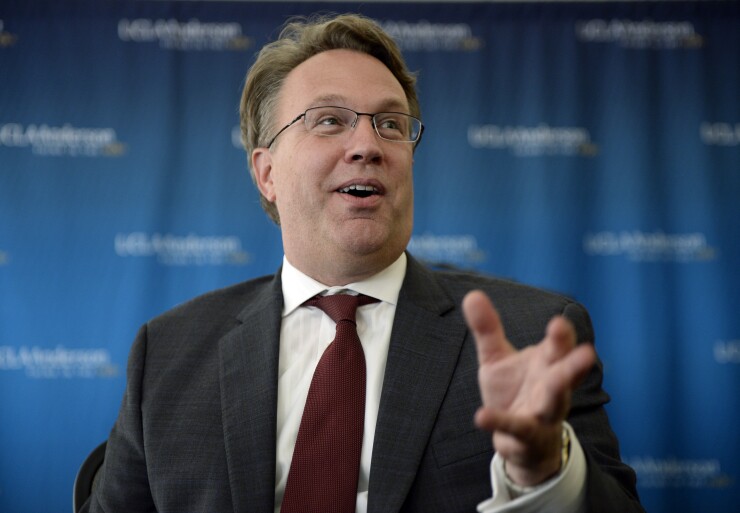While tariffs will certainly cause an uptick in inflation, the Federal Reserve can hold rates, according to Federal Reserve Bank of New York President John Williams.
Repeating the mantra that the U.S. remains in a “good place,” Williams said on Bloomberg Television, there is no need to adjust rates in either direction. Tariffs are already causing inflation and the impact will be greater as the tariffs increase, he said. But, since the economy has bounced back well from a “soft patch” last year, he has fewer concerns as he monitors sentiment for signs of skittishness that could derail the expansion.
"The economy is well positioned to deal with whatever events happen in the future," Williams said.

He estimated the duties will add “a few tenths” to inflation “over the next year,” while cutting demand “a bit and growth in the short run.” If tensions escalate, he said, “those effects would get even larger,” and could “affect consumer prices.” If that happens, “that's a significant effect."
Most analysts agree a deal will be reached … eventually. “Our base case is still that the U.S. and China will reach an agreement within a few months,” according to Berenberg Capital Markets.
However, much remains unpredictable “and the complexity of the negotiations ... extend well beyond trade,” leaving questions about “the timing of an agreement, the exact terms of any deal, the path to such a deal, and whether any of the tariffs will be removed,” Berenberg U.S. Economist Roiana Reid said in a note. “We would not be surprised to see more setbacks, bluster, and additional tariffs up until the point that a deal is actually agreed to and signed.”
So the road could be bumpy, and “markets should be prepared for continued uncertainty and further escalations of trade tensions,” she wrote. “But catalysts on both sides, including the U.S. presidential elections next year, China’s dependence on U.S. markets, and its already slowing potential growth should force both sides to a deal in the coming months.”
President Trump said he will meet with Chinese president Xi Jinping next month at the G-20 meeting, making a deal unlikely before then. He also tweeted, China will “probably” cut interest rates and pump “money into their system” to counteract the tariffs. "If the Federal Reserve ever did a ‘match,’ it would be game over, we win!,” the president wrote. “In any event, China wants a deal!"
But retaliation with tariffs “is just one arrow in China’s policy arsenal,” according to Thomas Prusa, professor and chair of economics at Rutgers University. “China’s government has a myriad of ways to intervene in markets and, doing so, they can make it much more difficult for U.S. firms to participate in the Chinese market.”
Although China doesn’t have a big position in municipal bonds, he added, “the threat of China reducing participation in the Treasury market would have an outsized impact (fear and uncertainty drive interest rates up). This, in turn, would impact the municipal bond market.”
Federal Reserve Bank of Kansas City President Esther George also addressed trade in a speech to the Economic Club of Minnesota, calling it a big risk in the medium term.
“To the extent slower foreign growth and waning fiscal and monetary stimulus represent a stronger headwind than I am building into my baseline forecast, we could see somewhat slower growth,” George said, according to prepared text released by the Fed. “Right now the data are noisy, and we need more time and evidence to judge whether this risk materializes.”
She added, monetary policy currently appears “appropriate,” but she has “legitimate concern” about how much “space” the Fed would have in a downturn.
Low but stable inflation “doesn’t demand a Fed policy response in my view,” she said. Trying to reach “a precise numerical target, while disregarding the labor market, the other leg of our dual mandate, strikes me as a degree of fine-tuning that goes beyond our span of control.”
“[L]ower interest rates might fuel asset price bubbles, create financial imbalances, and ultimately a recession,” she said.
Import prices
Iimport prices rose 0.2% in April, less than the 0.7% increase forecast by economists polled by IFR Markets. Higher fuel prices drove the gain, according to the Bureau of Labor Statistics. This followed a 0.6% rise in March.
“Despite the recent monthly advances, import prices declined 0.2% for the 12-month period ended in April,” BLS said. “The April year-over-year decrease was driven by lower non-fuel prices.”
Export prices also gained 0.2% in the month, following a 0.6% rise the prior month, and are up 0.3% year-over-year. Economists polled by IFR expected a 0.5% gain. “Rising prices for nonagricultural exports led the overall advance in April and more than offset a decline in prices for agricultural exports,” BLS said.
Small business optimism
The National Federation of Independent Business Small Business Optimism Index grew 1.7 points to 103.5 in April.
"The 'real' economy is doing very well versus what we see in financial market volatility," said NFIB Chief Economist Bill Dunkelberg. “Many jobs are being created, and GDP produced with no substantive inflation pressure. The pace of economic growth has accelerated, and consumers and small businesses are an important part of the improvement in sales."
Household debt rises
Total household debt grew $124 billion to $13.67 trillion in the first quarter, the 19th consecutive increase, the Federal Reserve Bank of New York reported.





